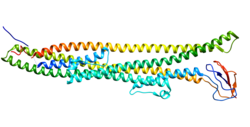
Back ليباز كبدي Arabic Hepatische Triglycerid-Lipase German Lipasa hepática Spanish Lipase hépatique French Lipase hepática Galician Печёночная липаза Russian Hepatik lipaz Turkish LIPC Tatar LIPC Ukrainian
Hepatic lipase (HL), also called hepatic triglyceride lipase (HTGL) or LIPC (for "lipase, hepatic"), is a form of lipase, catalyzing the hydrolysis of triacylglyceride. Hepatic lipase is coded by chromosome 15 and its gene is also often referred to as HTGL or LIPC.[5] Hepatic lipase is expressed mainly in liver cells, known as hepatocytes, and endothelial cells of the liver. The hepatic lipase can either remain attached to the liver or can unbind from the liver endothelial cells and is free to enter the body's circulation system.[6] When bound on the endothelial cells of the liver, it is often found bound to heparan sulfate proteoglycans (HSPG), keeping HL inactive and unable to bind to HDL (high-density lipoprotein) or IDL (intermediate-density lipoprotein).[7] When it is free in the bloodstream, however, it is found associated with HDL to maintain it inactive. This is because the triacylglycerides in HDL serve as a substrate, but the lipoprotein contains proteins around the triacylglycerides that can prevent the triacylglycerides from being broken down by HL.[8]
One of the principal functions of hepatic lipase is to convert intermediate-density lipoprotein (IDL) to low-density lipoprotein (LDL). Hepatic lipase thus plays an important role in triglyceride level regulation in the blood by maintaining steady levels of IDL, HDL and LDL.[5]

- ^ a b c GRCh38: Ensembl release 89: ENSG00000166035 – Ensembl, May 2017
- ^ a b c GRCm38: Ensembl release 89: ENSMUSG00000032207 – Ensembl, May 2017
- ^ "Human PubMed Reference:". National Center for Biotechnology Information, U.S. National Library of Medicine.
- ^ "Mouse PubMed Reference:". National Center for Biotechnology Information, U.S. National Library of Medicine.
- ^ a b Fox SI (2015). Human physiology (Fourteenth ed.). New York, NY: McGraw-Hill Education. ISBN 978-0-07-783637-5. OCLC 895500922.
- ^ Cite error: The named reference
pmid16397139was invoked but never defined (see the help page). - ^ Cite error: The named reference
Chatterjee_2011was invoked but never defined (see the help page). - ^ Cite error: The named reference
Cedó_2017was invoked but never defined (see the help page). - ^ PDB: 1HPL 1HPL; Bourne Y, Martinez C, Kerfelec B, Lombardo D, Chapus C, Cambillau C (May 1994). "Horse pancreatic lipase. The crystal structure refined at 2.3 A resolution". Journal of Molecular Biology. 238 (5): 709–32. doi:10.1006/jmbi.1994.1331. PMID 8182745.
© MMXXIII Rich X Search. We shall prevail. All rights reserved. Rich X Search





